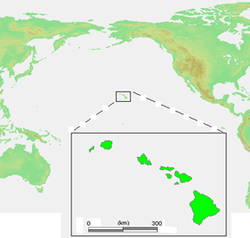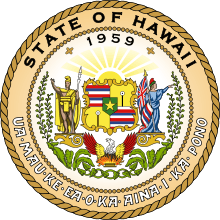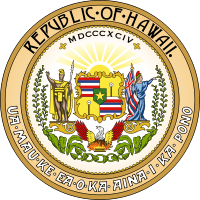Republic of Hawaii
| Republic of Hawaii | ||||||||||||
| Lepupalika ʻo Hawaiʻi | ||||||||||||
| ||||||||||||
| ||||||||||||
| Motto Ua Mau ke Ea o ka ʻĀina i ka Pono | ||||||||||||
| Anthem "Hawaiʻi Ponoʻī" | ||||||||||||
 Republic of Hawaii | ||||||||||||
| Capital | Honolulu | |||||||||||
| Languages | English, Hawaiian | |||||||||||
| Government | Republic One-party state | |||||||||||
| President | Sanford B. Dole | |||||||||||
| History | ||||||||||||
| • | Established | July 4, 1894 | ||||||||||
| • | Annexed by the US | August 12, 1898 | ||||||||||
| Area | ||||||||||||
| • | 1896 | 16,703 km² (6,449 sq mi) | ||||||||||
| Population | ||||||||||||
| • | 1896 est. | 109,020 | ||||||||||
| Density | 6.5 /km² (16.9 /sq mi) | |||||||||||
| Currency | Hawaiian dollar U.S. dollar | |||||||||||
| ||||||||||||
| Today part of | | |||||||||||
| Part of a series on the |
| History of Hawaii |
|---|
 |
| Timeline |
| Modern-day Hawaii |
|
|
The Republic of Hawaiʻi was the formal name of the nation of Hawaiʻi between July 4, 1894, when the Provisional Government of Hawaii ended, and August 12, 1898, when it was annexed by the United States as a territory of the United States. The Territory of Hawaii was formally established as part of the U.S. in June 14, 1900.
The Kingdom of Hawaii was overthrown in 1893 by citizens and residents favoring democracy over a monarchy model. Some American soldiers were present but only as observers, with the role to protect the hundreds of American lives and property in Honolulu.[1] The Republic of Hawaii was led by men of European ancestry, like Sanford B. Dole and Lorrin A. Thurston, who were native-born subjects of the Hawaiian kingdom and speakers of the Hawaiian language, but had strong financial, political, and family ties to the United States. Dole was a former member of the Kingdom legislature from Koloa, Kauai, and Justice of the Kingdom's Supreme Court, and he appointed Thurston—who had served as Minister of Interior under King Kalākaua—to lead a lobbying effort in Washington, DC to secure Hawaii's annexation by the United States.
Establishment of the Republic
.jpg)
Following the 1887 Bayonet Constitution that benefited the plantation owners,[2] and was dictated by the Missionary Party, and following the 1893 coup d'état carried out by more than 1,000 armed local men a temporary government was formed by the Committee of Safety until an assumed annexation by the U.S. Annexation was delayed by two petitions with over 20,000 signatures representing over half of the Native Hawaiian population. (see it at http://libweb.hawaii.edu/digicoll/annexation/petition.html ). The Queen herself took up residence in Washington, to lobby for her cause. President Grover Cleveland, a Democrat opposed to American expansion, sent an investigator who wrote the Blount Report. The report concluded that Minister Stevens had manipulated and orchestrated the revolt. Cleveland decided that the United States should restore the Queen; he asked for Dole's resignation. Dole ignored it. The U.S. Senate held hearings regarding the Morgan Report, undermining the Blount Report's claims. Public opinion in the United States favored annexation. In May 1894 the U.S. Senate unanimously passed a resolution opposing restoration of the Queen, opposing intrusion into the affairs of the Dole government, and opposing American action that could lead immediately to annexation. President Cleveland thereupon dropped the issue, leaving Hawaii to fend for itself.[3]
The Provisional Government convened a constitutional convention and established the Republic of Hawaiʻi on July 4, 1894.
Politics
The president of Hawaii was the republic's head of state and head of government. The constitution provided that the presidential term of office would be six years and specified that individuals could not be elected to consecutive terms in office. The President had the authority to veto legislation, which could be overridden by two-thirds majority in both houses of the legislature, and he was also commander-in-chief of the military. The President appointed, subject to the confirmation of the Senate, members of his Cabinet. Cabinet members were considered usurers of both houses of the Legislature, they could participate in proceedings, but could not vote as they were not elected members of the Legislature. If the presidency became vacant, the Minister of Foreign Affairs could serve as Acting President until the Legislature voted to elect a successor.
Article 23 of the 1894 Constitution specifically named Sanford B. Dole as the republic's first President. He would also be the nation's only President, as it was annexed by the United States in 1900. Upon annexation, Hawaii became a U.S. territory and Dole became its first Governor.[4]
The republic's Legislature consisted of a senate and a house of representatives. Each had fifteen members with the former having six-year terms and the latter only two with the exception of the first legislature which was constitutionally granted a three-year term. Appropriation bills originated from the Minister of Finance and were delivered to the Senate. The Senate also held the right to confirm presidential appointments and ratify treaties which made it more powerful in every aspect over the lower house. It was possible for legislators to concurrently serve as President, Cabinet Minister, or Supreme Court Justice.
As royalists had boycotted the republic and refused to take the oath of allegiance to run for office, the American Union Party won every seat in the 1894 and 1897 elections. There was also a property requirement of $1500 net worth to vote for Senators, kept from the 1887 constitution, which ran counter to the prevailing trends of that period. The 1897 election had the lowest turnout in Hawaii's history with less than one percent of the population going to the polls. The new Republic Constitution allowed only men that were natural born citizens of the Hawaiian Kingdom, or naturalized Citizens of the Kingdom to vote in the new Republic. This eliminated most all Japanese, Chinese, Portuguese, and European immigrants from voting. As a result, Polynesians had a two-thirds majority voting block and were the highest represented group in the Republic Legislature. The Speaker of the House of the Republic was also a Polynesian, J.L. Kaulukou.
Wilcox Rebellion of 1895

Robert William Wilcox was a Hawaiian native revolutionary. In 1889, he led an army of 150 Hawaiians, Europeans and Chinese in rebellion against the Hawaiian Kingdom. Wilcox was brought to trial but released as juries refused to find him guilty of wrongdoing. In 1895, Wilcox participated in another attempt, this time to overthrow the Republic of Hawaii and to restore Queen Liliuokalani to power. Royalist supporters landed a cargo of arms and ammunition from San Francisco, California in a secret Honolulu location. At the location on January 6, 1895, a company of royalists met to draft plans to capture the government buildings by surprise. A premature encounter with a squad of police alarmed Honolulu and the plans were abandoned as the royalists were quickly routed. Wilcox spent several days in hiding in the mountains before being captured. The son of one annexationist was killed. Several other skirmishes occurred during the following week resulting in the capture of the leading conspirators and their followers. The government found arms and ammunition and some potentially evidential documents on the premises of Washington Place, Liliuokalani's private residence, outlining in her own handwriting who she would select for her cabinet after the counter revolution, further implicating her in the plot.
Liliuokalani's trial
_cropped.jpg)
The Republic of Hawaii put the former queen on trial. The prosecution asserted that Liliuokalani had committed misprision of treason, because she allegedly knew that guns and bombs for the Wilcox attempted counter-revolution had been hidden in the flower bed of her personal residence at Washington Place. Liliuokalani denied these accusations.
She was sentenced to 5 years imprisonment at hard labor and a fine of $10,000. However, the imprisonment was served in a large bedroom with a piano, bathroom with hot and cold running water bathtub and sink at Iolani Palace where she was allowed two maids in waiting while under guard by military personnel at all times.[5] After eight months she was allowed to go to her Washington Place home and kept under house arrest by President Sanford B. Dole.[5] A year later she was granted a full pardon, including the right to travel; and President Dole gave her a passport to travel to Washington D.C. to visit her friends and in-laws. However, she used that opportunity to lobby the U.S. Senate in 1897 against annexation.
Dissolution of the Republic

Upon the inauguration of William McKinley as the 25th President of the United States on March 4, 1897, the Republic of Hawaii resumed negotiations for annexation, which continued into the summer of 1898. By this time, President McKinley and Republican leaders saw the islands as having gained a new strategic relevance in the central Pacific Ocean in the wake of the just concluded Spanish–American War, as argued by naval strategist Alfred Thayer Mahan.[6]
Furthermore, Japan showed an interest in taking control, as did Britain. On June 16 of that year, after a unanimous vote of the Republic of Hawaii Legislature, a new treaty of annexation offer was signed. As the U.S. Senate appeared uncertain to have a two-thirds majority to ratify the treaty alone, its supporters took alternative measures by passing it by way of a Congressional Executive Agreement method, so called the "Newlands Resolution" for Congressman Newlands that introduced the bill through which the treaty of cession offered by The Republic of Hawaii was accepted. As it turned out it was ratified and confirmed in the Senate by a vote of 42 to 21 (two-thirds majority) after all. The House of Representatives accepted the Newlands Resolution by a vote of 209 to 91 (over two-thirds majority). President McKinley signed the bill accepting the Republic of Hawaii's treaty offer on July 7, 1898. The formal claim of transfer of sovereignty took place on August 12, 1898 with the hoisting of the "Stars and Stripes" flag of the United States over the former royal Iolani Palace and renaming the island cluster as the Territory of Hawaii, which was formally organized two years later.
Notes
- ↑ Associated Press (16 August 2009). "Hawaii's Marks 50th Anniversary of Statehood: A brief history of Hawaii, from Polynesian voyagers to an island-born president". ABC News.
- ↑ William Ming Liu; Derek Kenji Iwamoto; Mark H. Chae (19 January 2011). Culturally Responsive Counseling with Asian American Men. Routledge. p. 133. ISBN 978-1-135-96833-5.
- ↑ Tennant S. McWilliams, "James H. Blount, the South, and Hawaiian Annexation," Pacific Historical Review (1988) 57#1 pp. 25-46 esp p 43
- ↑ Sanford Ballard Dole Encyclopædia Britannica
- 1 2 Hawaii's Story by Hawaii's Queen
- ↑ Peter Karsten, "The Nature of" Influence": Roosevelt, Mahan and the Concept of Sea Power." American Quarterly 23#4 (1971): 585-600. JSTOR
Bibliography
- Allen, Helena G. Sanford Ballard Dole: Hawaii's Only President, 1844-1926 (1998).
- Kuykendall, Ralph Simpson. Hawaii: A History, from Polynesian Kingdom to American State (1961)
- Schweizer, Niklaus R. His Hawaiian Excellency: The Overthrow of the Hawaiian Monarchy and the Annexation of Hawaii (1994).
External links
- morganreport.org Online images and transcriptions of the entire Morgan Report
| Wikimedia Commons has media related to Republic of Hawaii. |
Coordinates: 21°18′41″N 157°47′47″W / 21.3113888889°N 157.796388889°W
.svg.png)
